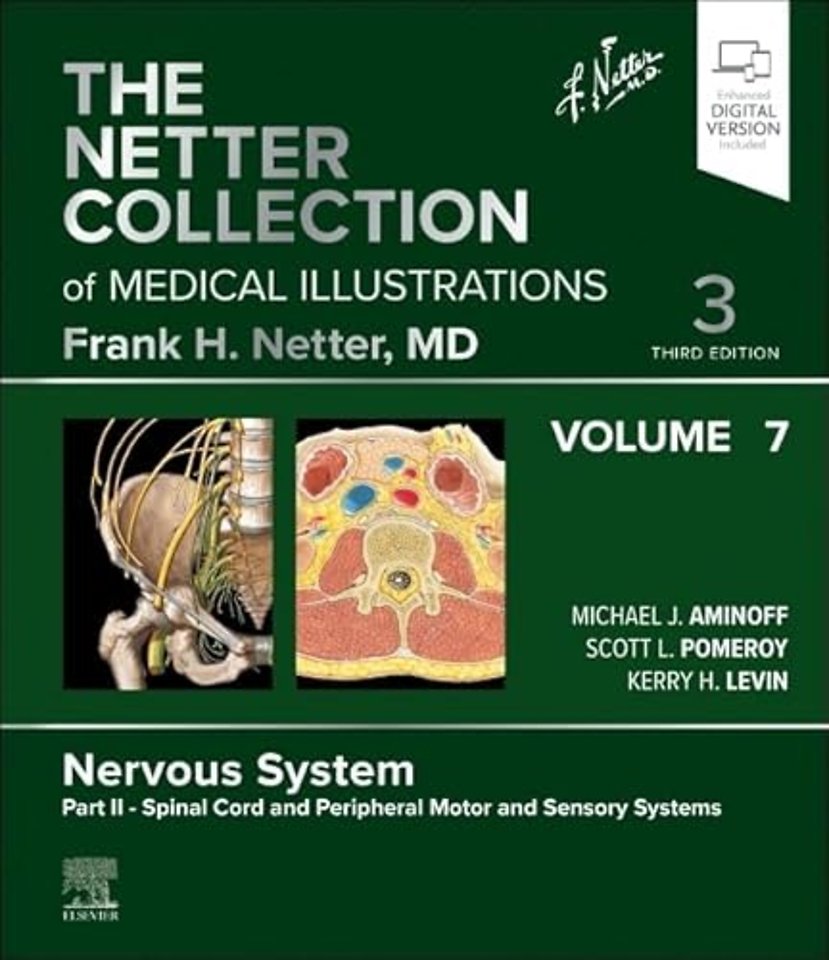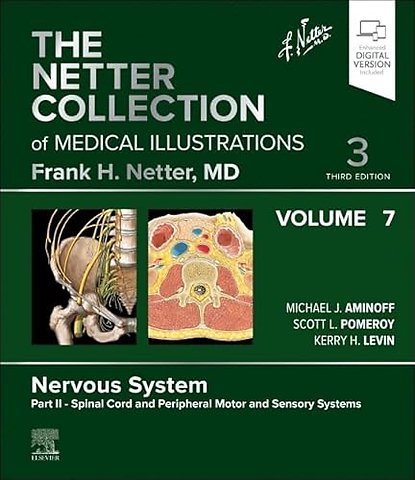SECTION 1 CRANIAL NERVE AND NEURO-OPHTHALMOLOGIC DISORDERS<br>Overview of Cranial Nerves<br>1.1 Distribution of Motor and Sensory Fibers<br>1.2 Overview of Cranial Nerves<br>1.3 Nerves and Nuclei Viewed in Phantom From Behind<br>1.4 Nerves and Nuclei in Lateral Dissection<br>Cranial Nerve I: Olfactory Nerve<br>1.5 Olfactory Pathways<br>1.6 Olfactory Receptors<br>1.7 Olfactory Bulb and Nerve<br>Cranial Nerve II: Optic Nerve<br>1.8 Eye<br>1.9 Cranial Nerve II and Visual Pathways<br>1.10 Optic Nerve Appearance<br>1.11 Retinal Projections to Thalamus, Midbrain, and Brainstem<br>1.12 Pupillary Light Reflex and the Accommodation Reflex<br>Cranial Nerves III, IV, and VI (Oculomotor, Trochlear, and Abducens)<br>1.13 Oculomotor (III), Trochlear (IV), and Abducens Nerves (VI)<br>1.14 Nerves of Orbit and Cavernous Sinus<br>1.15 Damage to Cranial Nerve III<br>1.16 Control of Eye Movements<br>1.17 Control of Eye Movements: Pathology<br>1.18 Control of Eye Movements: Pathology (Continued)<br>1.19 Autonomic Innervation of the Eye<br>Cranial Nerve V: Trigeminal Nerve<br>1.20 Trigeminal Nerve (V)<br>1.21 Trigeminal Nuclei: Afferent and Central Connections<br>1.22 Trigeminal Nuclei: Central and Peripheral Connections<br>1.23 Ophthalmic (V1) and Maxillary (V2) Nerves<br>1.24 Mandibular Nerve (V3)<br>1.25 Trigeminal Nerve Disorders<br>Cranial Nerve VII: Facial Nerve<br>1.26 Pons: Level of the Genu of the Facial Nerve<br>1.27 Facial Nerve (VII)<br>1.28 Muscles of Facial Expression: Lateral View<br>1.29 Central Versus Peripheral Facial Paralysis<br>1.30 Facial Palsy<br>Taste Receptors and Pathways<br>1.31 Anatomy of Taste Buds and Their Receptors<br>1.32 Tongue<br>Cranial Nerve VIII: Vestibulocochlear Nerve<br>1.33 Vestibulocochlear Nerve (VIII)<br>1.34 Pathway of Sound Reception<br>1.35 Pathologic Causes of Vertigo<br>1.36 Canalith Repositioning (Epley Maneuver)<br>1.37 Afferent Auditory Pathways<br>1.38 Centrifugal Auditory Pathways<br>1.39 Vestibular Receptors<br>1.40 Cochlear Receptors<br>Cranial Nerve IX: Glossopharyngeal Nerve and Otic Ganglion<br>1.41 Glossopharyngeal Nerve (IX)<br>1.42 Otic Ganglion<br>Cranial Nerve X: Vagus Nerve<br>1.43 Vagus Nerve (X)<br>1.44 Motor and Sensory Branches From the Vagus Nerve<br>1.45 Neurogenic Disorders of Mouth and Pharynx (X and XII)<br>Cranial Nerve XI: Accessory Nerve<br>1.46 Accessory Nerve (XI)<br>1.47 Clinical Findings in Cranial Nerve XI Damage<br>Cranial Nerve XII: Hypoglossal Nerve<br>1.48 Hypoglossal Nerve Intermedullary Course<br>1.49 Hypoglossal Nerve (XII)<br>1.50 Disorders of Hypoglossal Nucleus and Nerve<br><br>SECTION 2 SPINAL CORD: ANATOMY AND MYELOPATHIES<br>2.1 Spinal Cord<br>2.2 Spinal Membranes and Nerve Roots<br>2.3 Arteries of Spinal Cord and Nerve Roots<br>2.4 Arteries of Spinal Cord: Intrinsic Distribution<br>2.5 Veins of Spinal Cord, Nerve Roots, and Vertebrae<br>2.6 Principal Fiber Tracts of Spinal Cord<br>2.7 Somesthetic System of Body<br>2.8 Corticospinal (Pyramidal) System: Motor Component<br>2.9 Rubrospinal Tract<br>2.10 Vestibulospinal Tracts<br>2.11 Reticulospinal and Corticoreticular Pathways<br>2.12 Spinal Origin or Termination of Major Descending Tracts and Ascending Pathways<br>2.13 Cytoarchitecture of Spinal Cord Gray Matter<br>2.14 Spinal Effector Mechanisms<br>2.15 Spinal Reflex Pathways<br>2.16 Spinal Cord Dysfunction<br>2.17 Sensory Impairment Related to Level of Spinal Cord Injury<br>2.18 Incomplete Spinal Cord Syndromes<br>2.19 Acute Spinal Cord Syndromes<br>2.20 Acute Spinal Cord Syndromes: Pathology, Etiology, and Diagnosis<br>2.21 Spinal Tumors<br>2.22 Extramedullary and Intramedullary Spinal Cord Tumors<br>2.23 Neuroimaging (MRI) Characteristics of Spinal Tumors<br>2.24 Syringomyelia<br>2.25 Subacute Combined Degeneration<br>2.26 Spinal Dural Fistulas and Arteriovenous Malformations<br>2.27 Cervical Spondylosis<br>2.28 Cervical Disk Herniation Causing Cord Compression<br>2.29 Infectious and Hereditary Myelopathies<br><br>SECTION 3 SPINAL TRAUMA<br>3.1 Spinal Column<br>3.2 Atlas and Axis<br>3.3 Cervical Vertebrae<br>3.4 External Craniocervical Ligaments<br>3.5 Internal Craniocervical Ligaments<br>3.6 Thoracic Vertebrae<br>3.7 Lumbar Vertebrae and Intervertebral Disk<br>3.8 Sacrum and Coccyx<br>3.9 Ligaments of Sacrum and Coccyx<br>3.10 Biomechanics of Spine and Spinal Cord Injuries: Distractive Flexion<br>3.11 Biomechanics of Spine and Spinal Cord Injuries: Compressive Flexion<br>3.12 Biomechanics of Spine and Spinal Cord Injuries: Distractive Extension<br>3.13 Cervical Spine Injury: Prehospital, Emergency Department, and Acute Management<br>3.14 Traction and Bracing<br>3.15 Anterior Cervical Spine Decompression and Stabilization<br>3.16 Posterior Cervical Stabilization and Fusion<br>3.17 Spinal Cord Injury Medical Issues<br><br>SECTION 4 NERVE ROOTS AND PLEXUS DISORDERS<br>4.1 Cervical Disk Herniation<br>4.2 Radiographic Diagnosis of Radiculopathy<br>4.3 Back Pain and Lumbar Disk Disease<br>4.4 Lumbar Disk Herniation: Clinical Manifestations<br>4.5 L4–5 Disk Extrusion<br>4.6 Lumbosacral Spinal Stenosis<br>4.7 Spinal Nerves<br>4.8 Dermal Segmentation<br>4.9 Thoracic Nerves<br>4.10 Thoracic Spinal Nerve Root Disorders<br>4.11 Diabetic Lumbosacral Radiculoplexus Neuropathy<br>4.12 Lumbar, Sacral, and Coccygeal Plexuses<br>4.13 Brachial Plexus<br>4.14 Brachial Plexus and Cervical Nerve Root Injuries at Birth<br>4.15 Brachial Plexopathy<br>4.16 Lumbosacral Plexopathy<br>4.17 Cervical Plexus<br><br>SECTION 5 MONONEUROPATHIES<br>5.1 Compression Neuropathies<br>5.2 Chronic Nerve Compression<br>5.3 Evaluation of Mononeuropathies<br>5.4 Radiologic Studies in Compression Neuropathy<br>5.5 Proximal Nerves of the Upper Extremity<br>5.6 Suprascapular and Musculocutaneous Nerves<br>5.7 Median Nerve<br>5.8 Proximal Median Neuropathies<br>5.9 Distal Median Neuropathies: Carpal Tunnel Syndrome<br>5.10 Distal Median Neuropathies: Carpal Tunnel Syndrome (Continued)<br>5.11 Ulnar Nerve<br>5.12 Ulnar Mononeuropathies: Potential Entrapment Sites<br>5.13 Radial Nerve<br>5.14 Radial Nerve Compression and Entrapment Neuropathies<br>5.15 Femoral and Lateral Femoral Cutaneous Nerves<br>5.16 Iliohypogastric, Ilioinguinal, Genitofemoral, and Obturator Nerves<br>5.17 Sciatic and Gluteal Nerves<br>5.18 Sciatic and Posterior Femoral Cutaneous Nerves<br>5.19 Fibular (Peroneal) and Tibial Nerves<br>5.20 Peroneal Nerve Compression<br>5.21 Tibial Nerve<br>5.22 Dermatomal and Cutaneous Nerve Patterns<br>5.23 Dermatomes<br><br>SECTION 6 PERIPHERAL NEUROPATHIES<br>6.1 Peripheral Nerve<br>6.2 Histology of Peripheral Nerve<br>6.3 Cell Types of Nervous System<br>6.4 Resting Membrane Potential<br>6.5 Ion Channel Mechanics and Action Potential Generation<br>6.6 Neurophysiology and Peripheral Nerve Demyelination<br>6.7 Impulse Propagation<br>6.8 Conduction Velocity<br>6.9 Visceral Efferent Endings<br>6.10 Cutaneous Receptors<br>6.11 Pacinian Corpuscle<br>6.12 Muscle and Joint Receptors<br>6.13 Proprioceptive Reflex Control of Muscle Tension<br>6.14 Charcot-Marie-Tooth Disease Overview (Hereditary Motor and Sensory Neuropathy)<br>6.15 Charcot-Marie-Tooth Disease: Common Types<br>6.16 Early Onset and Other Rare Forms of Charcot-Marie-Tooth Disease and Inherited Neuropathies<br>6.17 Hereditary Sensory and Autonomic Neuropathy<br>6.18 Guillain-Barré Syndrome<br>6.19 Guillain-Barré Syndrome (Continued)<br>6.20 Chronic Inflammatory Demyelinating Polyradiculoneuropathy<br>6.21 Diabetic Neuropathies<br>6.22 Monoclonal Protein–Associated Neuropathies<br>6.23 Distal Acquired Demyelinating Symmetric (DADS) Neuropathy<br>6.24 Vasculitic Neuropathy and Other Connective Tissue Disorders Associated With Neuropathy<br>6.25 Sjögren Syndrome<br>6.26 Immunopathogenesis of Guillain-Barré Syndrome<br>6.27 Peripheral Neuropathy Caused by Heavy Metal Poisoning<br>6.28 Metabolic, Toxic, and Nutritional Peripheral Neuropathies<br>6.29 Leprosy and Other Infections Sometimes Causing Peripheral Neuropathy<br><br>SECTION 7 AUTONOMIC NERVOUS SYSTEM AND ITS DISORDERS<br>7.1 General Topography of Autonomic Nervous System<br>7.2 General Topography of Autonomic Nervous System (Continued)<br>7.3 Autonomic Reflex Pathways<br>7.4 Cholinergic and Adrenergic Nerves<br>7.5 Autonomic Nerves in Head and Neck<br>7.6 Autonomic Nerves in Neck<br>7.7 Autonomic Innervation of Eye<br>7.8 Autonomic Innervation of Eye (Continued)<br>7.9 Autonomic Nerves in Thorax<br>7.10 Innervation of Heart<br>7.11 Innervation of Blood Vessels<br>7.12 Carotid Body and Carotid Sinus<br>7.13 Autonomic Nerves and Ganglia in Abdomen<br>7.14 Innervation of Stomach and Proximal Duodenum<br>7.15 Innervation of Intestines<br>7.16 Autonomic Innervation of Small Intestine<br>7.17 Enteric Plexuses<br>7.18 Innervation of Liver and Biliary Tract<br>7.19 Innervation of Adrenal Glands<br>7.20 Autonomic Nerves and Ganglia in Pelvis<br>7.21 Innervation of Kidneys, Ureters, and Urinary Bladder<br>7.22 Innervation of Urinary Bladder and Lower Ureter<br>7.23 Innervation of Reproductive Organs<br>7.24 Female Reproductive Organs<br>7.25 Autonomic Testing<br>7.26 Cardiovagal Testing and Head-up Tilting<br>7.27 Abnormal Pupillary Conditions<br>7.28 Clinical Presentation of Autonomic Disorders<br>7.29 Multiple System Atrophy<br><br>SECTION 8 PAIN<br>8.1 Neuroanatomy of the Ascending Pain Pathways<br>8.2 Neuroanatomy of the Ascending Pain Pathways (Continued)<br>8.3 Descending Nociceptive Pathways and Neurochemical Foundations of Descending Pain Modulation<br>8.4 Endorphin System<br>8.5 Nociceptive Processing and Central Nervous System Correlates of Pain<br>8.6 Central Nervous System Neurotransmitters, Receptors, and Drug Targets<br>8.7 Thalamic Pain Syndrome<br>8.8 Clinical Manifestations Related to Thalamus Site in Intracerebral Hemorrhage<br>8.9 Complex Regional Pain<br>8.10 Herpes Zoster<br>8.11 Occipital Neuralgia<br>8.12 Myofascial Factors in Low Back Pain<br>8.13 Posterior Abdominal Wall: Internal View<br>8.14 Lumbar Zygapophyseal Joint Back Pain<br>8.15 Low Back Pain and Effects of Lumbar Hyperlordosis and Flexion on Spinal Nerves<br>8.16 Examination of the Patient With Low Back Pain<br>8.17 Osteoporosis<br>8.18 Diagnosis of Low Back, Buttock, and Hip Pain<br>8.19 Hip Joint Involvement in Osteoarthritis<br>8.20 Painful Peripheral Neuropathy<br>8.21 Peripheral Neuropathies: Clinical Manifestations<br>8.22 Functional Neurologic Disorders<br>8.23 Somatoform Conversion Reactions<br><br>SECTION 9 FLOPPY INFANT<br>9.1 Neonatal Hypotonia<br>9.2 Congenital Myopathies<br>9.3 Spinal Muscular Atrophy<br>9.4 Treatment for Spinal Muscular Atrophy<br>9.5 Infantile Neuromuscular Junction Disorders<br>9.6 Arthrogryposis Multiplex Congenita<br><br>SECTION 10 MOTOR NEURON AND ITS DISORDERS<br>10.1 Peripheral Nervous System: Overview<br>10.2 Spinal Cord and Neuronal Cell Body With Motor, Sensory, and Autonomic Components of the Peripheral Nerve<br>10.3 Motor Unit<br>10.4 Motor Unit Potentials<br>10.5 Primary Motor Neuron Disease<br>10.6 Amyotrophic Lateral Sclerosis<br>10.7 Clinical Manifestations of Amyotrophic Lateral Sclerosis (Continued)<br>10.8 Mimics of Amyotrophic Lateral Sclerosis<br>10.9 Diagnosis of Amyotrophic Lateral Sclerosis<br>10.10 Treatment of Amyotrophic Lateral Sclerosis<br>10.11 Spinal Muscular Atrophy and Spinal Bulbar Muscular Atrophy<br><br>SECTION 11 NEUROMUSCULAR JUNCTION AND ITS DISORDERS<br>11.1 Neuromuscular Junction<br>11.2 Physiology of Neuromuscular Junction<br>11.3 Synaptic Transmission<br>11.4 Synaptic Transmission (Continued)<br>11.5 Repetitive Motor Nerve Stimulation<br>11.6 Patient With Lambert-Eaton Myasthenic Syndrome<br>11.7 Myasthenia Gravis<br>11.8 Myasthenia Gravis (Continued)<br>11.9 Immunopathology of Myasthenia Gravis<br>11.10 Presynaptic Neuromuscular Junction Transmission Disorders: Lambert-Eaton Myasthenic Syndrome and Infantile Botulism<br>11.11 Congenital Myasthenic Syndromes<br>11.12 Foodborne Neurotoxins<br><br>SECTION 12 MUSCLE AND ITS DISORDERS<br>12.1 Muscle Fiber Anatomy: Basic Sarcomere Subdivisions<br>12.2 Muscle Fiber Anatomy: Biochemical Mechanics of Contraction<br>12.3 Muscle Membrane, T Tubules, and Sarcoplasmic Reticulum<br>12.4 Muscle Response to Nerve Stimulation<br>12.5 Metabolism of Muscle Cell<br>12.6 Muscle Fiber Types<br>12.7 Overview of Myopathies: Clinical Approach<br>12.8 Dystrophinopathies<br>12.9 Duchenne Muscular Dystrophy<br>12.10 Dystrophinopathies (Continued)<br>12.11 Myotonic Dystrophy and Other Myotonic Disorders<br>12.12 Myotonic Dystrophy and Other Myotonic Disorders (Continued)<br>12.13 Other Types of Muscular Dystrophy<br>12.14 Polymyositis and Dermatomyositis<br>12.15 Polymyositis and Dermatomyositis (Continued)<br>12.16 Inclusion Body Myositis<br>12.17 Immunopathogenesis of Inflammatory Myopathies<br>12.18 Endocrine, Toxic, and Critical Illness Myopathies<br>12.19 Myopathies: Hypokalemia/Hyperkalemia and Periodic Paralyses Channelopathies<br>12.20 Metabolic and Mitochondrial Myopathies<br>12.21 Myoglobinuric Syndromes Including Malignant Hyperthermia

